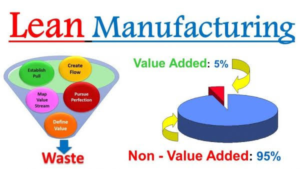Manufacturers strive to increase productivity, cut costs, and efficiently deliver high-quality goods in today’s competitive business environment. Lean manufacturing gives an extensive structure to accomplish these objectives by zeroing in on upgrading efficiency and eliminating waste all through the creation cycle.
Businesses can optimize their operations, increase efficiency, and ultimately drive sustainable growth by adhering to the principles of lean manufacturing. We will delve into the principles of lean manufacturing to improve productivity while reducing waste in this article.
5 Notable Principles of Lean Manufacturing
-
Value Stream Mapping: Unleashing the Power of Lean Manufacturing for Productivity Enhancement
Lean manufacturing’s value stream mapping is one of its fundamental principles. To identify and eliminate waste, this practice involves visually mapping the entire production process, from raw materials to finished goods.
By completely understanding the progression of materials and data, organizations can distinguish bottlenecks, diminish lead times, and streamline operations.
Value stream mapping engages associations to upgrade efficiency by eliminating non-value-added activities, further developing process flow, and carrying out lean practices all through the value stream.
-
Just-in-Time (JIT) Production: Maximizing Efficiency and Minimizing Inventory
Just-in-time (JIT) production is another essential principle of lean manufacturing that aims to minimize inventory levels and associated costs by producing goods or providing services at the precise moment of need. By synchronizing creation with customer demand, organizations can decrease waste, upgrade effectiveness, and answer rapidly to changing economic situations.
JIT production streamlines efficiency by diminishing lead times, wiping out excess inventory, and further developing income. Businesses can meet customer expectations while reducing waste thanks to this culture of efficiency and adaptability.

-
Kaizen: Cultivating a Culture of Continuous Improvement in Lean Manufacturing
The standard of Kaizen is indispensable to lean manufacturing. It centers around ceaseless improvement in all parts of the manufacturing process, engaging representatives to distinguish opportunities for upgrade and disposal of waste. A culture of engagement, teamwork, and problem-solving is promoted by Kaizen.
Organizations can benefit significantly from the expertise and experience of their workforce by involving workers at all levels. Through little, gradual changes, organizations can advance cycles, decrease waste, and improve efficiency after some time. Kaizen fosters a mindset of continuous improvement, making efficiency improvement an ongoing endeavor.
5S Methodology: Creating an Organized and Efficient Work Environment
The 5S methodology is a powerful tool for achieving organization and efficiency in lean manufacturing. It can be used to create an organized and efficient workplace, comprising five principles: Sort, Set in Order, Shine, Standardize, and Sustain.
Businesses can improve productivity and reduce waste by creating a neat and organized work environment via adhering to these principles.
The Sort step involves removing items that aren’t needed. Set in Order establishes a logical arrangement of tools and materials, shine ensures cleanliness and routine maintenance, Standardize establishes guidelines for consistent practices, and Sustain ensures long-term adherence to the 5S principles.
The 5S procedure encourages a climate that promotes productivity, wellbeing, and a feeling of satisfaction in the work environment.
Total Productive Maintenance (TPM): Optimizing Equipment Performance and Minimizing Downtime
The principle of Total Productive Maintenance (TPM) centers around boosting equipment performance, diminishing breakdowns, and limiting free time. Organizations place a priority on proactive equipment maintenance and involve operators in routine care and inspections by implementing TPM.
It intends to accomplish ideal hardware viability through a blend of autonomous maintenance, planned maintenance, and continuous improvement initiatives. This standard improves efficiency by guaranteeing equipment unwavering quality, decreasing unforeseen breakdowns, and optimizing production capacity.
Conclusion
A solid foundation for increasing productivity and eliminating waste in manufacturing operations is provided by the principles of lean manufacturing. Businesses are able to streamline operations and reduce non-value-added activities by adopting value stream mapping, which provides them with a comprehensive understanding of their processes.
Just-in-time production empowers associations to streamline production with customer demand and minimizing inventory.
Employees are empowered to identify opportunities for improvement and waste reduction when a culture of continuous improvement is fostered through kaizen.
The 5S procedure advances a coordinated and proficient workplace, driving productivity gains and diminishing waste. Total Productive Maintenance, or TPM, guarantees the optimal equipment performance, reduces downtime, and maximizes production capacity.
Businesses can realize their potential for increased productivity, efficiency, and customer satisfaction by adhering to these principles. The principles of lean manufacturing can be applied to a wide range of industries looking to streamline operations and eliminate waste. They are not only applicable to the manufacturing sector.
Through the use of lean assembling standards, associations can develop a culture of persistent improvement, driving manageable development and keeping an upper hand in the commercial center.



